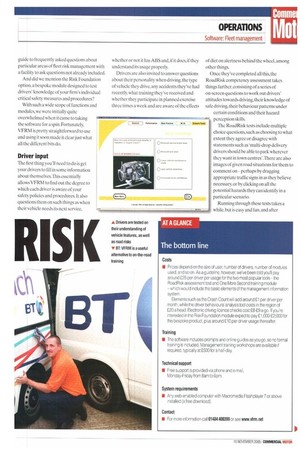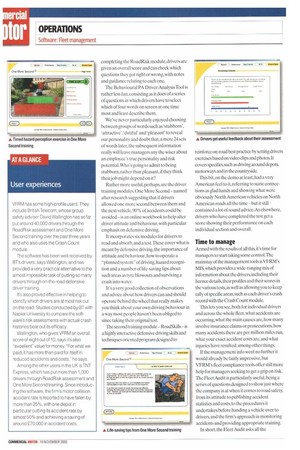A QUESTION 0 1
Page 62

Page 63

Page 64

Page 65

If you've noticed an error in this article please click here to report it so we can fix it.
Running a fleet isn't just about vehicles and
drivers — it's also about managing risk. Robin Meczes reviews an online so'tvvare suite that will help you do so with ease. In many ways risk management is at the very nub of fleet management these days, partly because costs can be significantly reduced by successfully managing risk and partly because exposure to litigation in the event of something going wrong increasingly seems to depend on being able to prove you've done all you can to reduce risks.
A good basis, then, for a software product designed to help you cover all the angles when it comes to managing the risks inherent in running a fleet.
Which is what Virtual Fleet Risk Manager (VFRM) from Interactive Driving Systems is all about.
Trying to describe VFRM isn't easy because there's an initially bewildering array of different modules and functions in it. Perhaps the core parts of the system, however, are RoadRisk, a competency assessment tool for drivers, and One More Second, a training module with heavy emphasis on defensive driving techniques. You can , if you want,just buy into these two modules and look no further. But for the more adventurous, there's much more.
The Road Risk competency assessments are complemented.for example.by a driver Behavioural PA Driver Analysis Tool, which uses the DISC (dominance, influence, submission and compliance) behaviour profiling system to establish your drivers' key personality traits and suitability for work behind the wheel.
Driver training, meanwhile, can be extended with a further, multimediabased RoadSkills module.
And the Management Information System (MIS), the essential management module that allows managers to keep up with which drivers have done which bits of the software and their results, can be extended to include things such as electronic licence checks for drivers and Crash Count, a tool to record and analyse accidents and incidents.
As ir all this weren't enough, you can also elect to undergo a full Flee t. Audit — a series of questions designed to help you assess how well your company is already managing risk and which areas need particular attention .Therc's also an FAQ/Ask The Experts facility —a basic guide to frequently asked questions about particular areas of fleet risk management with a facility to ask questions not already included.
And did we mention the Risk Foundation option, a bespoke module designed to test drivers' knowledge of your firm's individual critical safety measures and procedures?
With such a wide scope of functions and modules, we were initially quite overwhelmed when it came to taking the software for a spin. Fortunately, VFRM is pretty straightforward to use and using it soon made it clear just what all the different bits do.
Driver input The first thing you'll need to do is get your drivers to fill in some information about themselves.This essentially allows VFRM to find out the degree to which each driver is aware of your safety policies and procedures. It also questions them on such things as when their vehicle needs its next service, whether or not it has ABS and, if it does,if they understand its usage properly.
Drivers are also invited to answer questions about their personality when driving, the type of vehicle they drive, any accidents they've had recently, what training they've received and whether they participate in planned exercise three times a week and are aware of the effects of diet on alertness behind the wheel. among other things.
Once they've completed all this, the RoadRisk competency assessment takes things further, consisting of a series of on-screen questions to work out drivers' attitudes towards driving, their knowledge of safe driving, their behaviour patterns under certain conditions and their hazard perception skills.
The Road Risk tests include multiple choice questions, such as choosing to what extent they agree or disagree with statements such as 'multi-drop delivery drivers should be able to park wherever they want in town centres' .There are also images of given road situations for them to comment on by dragging appropriate traffic signs in as they believe necessary, or by clicking on all the potential hazards they can identify in a particular scenario.
Running through these tests takes a while, but is easy and fun, and after completing the RoadRisk module, drivers are given an overall score and can check which questions they got right or wrong, with notes and guidance relating to each one.
The Behavioural PA Driver Analysis Tool is rather less fun,consisting as it does of a series of questions in which drivers have to select which of four words on screen at one time most and least describe them.
We've never particularly enjoyed choosing between groups of words such as 'stubborn', `attractive'.`dutifuf and 'pleasant' to reveal our personality and doubt that, a mere 24 sets of words later, the subsequent information really will leave managers any the wiser about an employee's true personality and risk potential.Who's going to admit to being stubborn, rather than pleasant, if they think their job might depend on it?
Rather more useful, perhaps, are the driver training modules. One More Second — named after research suggesting that if drivers allowed one more second between them and the next vehicle. 90% of accidents could be avoided — is an online workbook to help alter driver attitude and behaviour, with particular emphasis on defensive driving.
It incorporates six modules for drivers to read and absorb, and a test.lhese cover what is meant by defensive driving, the importance of attitude and behaviour, how to operate a "planned system" of driving, hazard recognition and a number of life-saving tips about such areas as tyre blowouts and surviving a crash into water.
It's a very good collection of observations and advice about how drivers can and should operate behind the wheel that really makes you think about your own driving behaviour in a way most people haven't been obliged to since taking their original test.
The second training module— RoadSkills — is a highly interactive defensive driving skills and techniques oriented program designed to reinforce on-road best practice by setting drivers exercises based on video clips and photos. It covers specifics,such as driving around depots, motorways and in the countryside.
This bit, on the demo at least, had a very American feel to it, referring to suzie connections as glad hands and showing what were obviously North American vehicles on North American roads all the time — but it still contained a lot of sound advice. As elsewhere, drivers who have completed the test get a score showing their performance on each individual section and overall.
Time to manage
Armed with the results of all this, it's time for managers to start taking some control.The mainstay of the management tools is VFRM's MIS, which provides a wide-ranging mix of information about the drivers, including their licence details, their profiles and their scores in the various tests, as well as allowing you to keep tally of specific areas,such as each driver's crash record with the Crash Count module.
This lets you see, both for individual drivers and across the whole fleet,wh at accidents are occurring, what the main causes are, how many involve insurance claims or prosecutions, how many accidents there are per million miles run, what your exact accident costs are, and what injuries have resulted, among other things.
If the management info went no further it would already be fairly impressive, but VFRM's fleet compliance tools offer still more help for managers seeking to get a grip on risk. The Fleet Audit is particularly useful, being a series of questions designed to show just where the company is at when it comes to road safety, from its attitude to publishing accident statistics and costs, to the procedures it undertakes before handing a vehicle over to drivers, and the firm's approach in monitoring accidents and providing appropriate training.
In short, the Fleet Audit asks all the questions fleet managers should be able to answer if they're serious about achieving a risk-free culture._ and provides you with some feedback on your progress towards that goal.
Reducing risk
Space doesn't permit us to go into as much detail as we'd like about the scope and quality of VFRM, but suffice to say that if you did nothing more than run all your drivers through the driver assessment and online training modules, you'd be doing yourself a very serious favour in terms of reducing the risk of serious accidents just by making your drivers think a bit more about the way they drive.
If you were then to start taking a more active management interest in the results of their tests and tailor things—say with a bit ofjudicial on-the-road defensive driver training or just by chatting with individual drivers about the results— we suspect you'd see an improvement in accident rates and severity very quickly.
There were one or two very minor things about this software suite that jarred a bit. Some very precise mousework is needed when you're clicking on potential hazards in some of the driver assessment exercises, for instance — but this really is negligible.
The only other slightly negative thing we can say about VFRM is that there isn't much in it to help you manage vehicle-related risks— in particular there is no facility to record and manage vehicle inspections, maintenance and servicing. But given that most accidents are usually caused by driver, rather than vehicle error, this is hardly a major concern.
Overall, VFRM looks like an excellent set of tools to help you manage every element of driver-related risk.And in a world where accident rates and corporate manslaughter legislation weigh heavily on the shoulders of anyone managing a fleet, this software has got to be well worth looking at. ei






































































































































































































